|
There is a popular trend among handgun hunters towards heavier bullets,
with the goal of increased penetration. While a 300 grain bullet in either a .44
Magnum or a .45 Colt will shoot through a deer from pretty much any angle, many
hunters dream of hunting larger game, and spend a lot of time thinking about
even heavier bullets to obtain similar performance on elk, moose, buffalo and
the like. This door to this level of revolver performance was opened by J. D.
Jones back in the early 1980s when he introduced his cast bullet designs, and
most notably the 320 grain SSK .44 Magnum bullet. At that point in time, most
bullet manufacturers were limiting their .44 bullets to 250-265 grains. J. D.
saw a need for well-designed heavier bullets and answered that need by
developing the JDJ line of bullet moulds. In the years that have passed since,
others have followed suit with their own designs. The question then arises as to
when does more weight become too much weight for the .44 Magnum? The
"conventional wisdom" is that a 300 grain bullet (either cast or jacketed) is
the optimum "heavy bullet" weight for the .44 Magnum, and that anything heavier
compromises terminal performance by limiting muzzle velocity. Is this really
true, or is it just more gun-shop hot air? The 320 grain SSK has an excellent
reputation, having taken everything from elk to elephant, but are some of the
newer .44 heavyweights even better? There are commercial .44 Magnum loads that
go up to 350 grains, and commercial hardcast bullets that allow the handloader
to go as heavy as 405 grains. For example, Randy Garrett uses 310 grain bullets
(with a .320" meplat) at 1325 fps in his Sledgehammer .44 Magnum loads (Garrett
Cartridges). Cor-Bon has hardcast
heavyweight loads featuring a 305 grain flat-point penetrator at 1300 fps, and a
320 grainer at 1270 fps. Buffalo Bore
offers a 305 grain LBT LFN at 1325 fps, and has a commentary on their website
about overly large meplats and how they can limit penetration. These are some of
the 300+ grain loads that are marketed for all .44 Magnum revolvers, there are
also heavier loads marketed specifically for the Ruger Super Redhawk that are
too long for the "standard" .44 Magnum revolvers (e.g. Garrett's .44 Magnum
Hammerhead +P ammo with a 330 grain long-nosed bullet at 1400 fps, with a .320"
meplat).
Commercial hardcast heavyweights are also available as components. For
example, Cast Performance offers
320 grain WLN bullets for handgun hunters. In addition,
Beartooth offers .44 caliber
heavyweights in 325, 330, 355 and 405 grains, in a variety of nose
configurations.
The question then becomes, is all this extra weight useful for a .44
Magnum revolver, or is it just too much of a good thing? I decided to do some
testing with a wide variety of heavyweight cast bullets in the .44 Magnum to see
what I could learn. There is very little reason to look for expanding designs in
this weight range for the .44 Magnum for the simple reason that bullets in this
weight range are chosen for deep penetration and expansion would be
counter-productive. The purpose of this article is to examine some of the
various 300+ grain cast bullet designs that are available and evaluate their
performance in typical hunting guns.
So, let's take a tour of some of the heavyweights and see how they
shoot. I'm going to simplify things and just accept that W296 is the most
popular powder for high performance heavyweight .44 Magnum loads and stick with
that one powder. Yes, other powders work just fine for this class of load, but
if you can't make a bullet shoot in .44 Magnum with W296, then it's unlikely
that that bullet is going to shoot well with any other powder. Likewise,
previous experience has shown me that the top performing primer (both in terms
of velocity and accuracy) in the .44 Magnum is CCI 350, so I'm going to stick
with that one primer for the following comparisons. Choice of guns was also
straightforward -- I prefer to shoot lighter bullets in my S&Ws (like the
429421, the 429640 HP and the LBT 280 WFN), and save the heavier stuff for my
Rugers, so I picked out a pair of 7 1/2" Super Blackhawks (SBH's) for these
comparisons, and also ran these loads through my Marlin 1894 .44 Magnum
lever-gun. Yes, stiffer loads +P can be assembled for the Ruger Super Redhawk,
Dan Wesson and Colt Anaconda revolvers, but I was interested in answering this
question for "standard" .44 Magnum revolver loads (the same trends will likely
hold true for the +P loads, just offset to somewhat higher velocities).
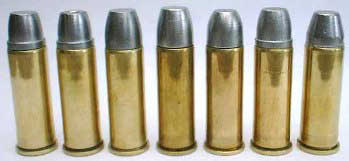 |
|
Pictures of some of the bullets tested. |
|
All bullets were cast from WW alloy, sweetened with approximately 2%
added tin. Bullets were sized .430", except for the Lyman 429649 340 grain GCFP
and the NEI 365 grain ogival wadcutter, which were sized .429" so that these
tubby bullets would chamber. Both of these bullets have extended full diameter
sections on their noses and would not chamber in the test revolvers if sized
.430". None of the loads discussed below displayed any signs of excessive
pressure.
The Saeco 300 grain GC-RNFP was loaded on top of 21.5 grains W296. From
the 7 1/2" Super Blackhawk this load generated 1373 fps with reasonable
accuracy. This load fed from the Marlin's magazine superbly and delivered
excellent accuracy at 1679 fps.
The LBT 300 LFN was also tested over the same load (21.5/W296).
Similarly, it delivered so-so accuracy from the SBH, and velocity was measured
at 1326 fps. The Marlin carbine cycled this combination smoothly, and delivered
good accuracy and 1711 fps. As a side note, the ogive and meplat on the LBT 300
LFN are virtually identical to the Lyman 429640 (275 grain), the LBT is just a
little longer, heavier, has more grease grooves and is a PB design (the Lyman is
a GC design). NEI has a very similar plain-based bullet listed as the 290-429-PB
(#263) that gave virtually identical performance.
The RCBS 300 GC-SWC weighs 303 grains when cast of WW alloy, so it was
seated over the same test load (21.5/W296). This bullet delivered excellent
accuracy from the stainless SBH at 1372 fps.
The Lyman 300 GC-SWC (#429650) weighs 310 grains when cast of WW alloy,
so I chose to reduce the test load 0.5 grain (21.0/W296). This combination
provided excellent accuracy and 1379 fps from the sixgun. It fed just fine from
the magazine of the lever-gun, and demonstrated decent accuracy (1708 fps).
Informal plinking at softball-sized rocks at 150 yards verified that these
bullets were fully stabilized by the 1 in 38" twist and flying true.
J. D. Jones of SSK Industries designed a series of heavyweight
flat-pointed bullets for handgun hunters back in the 1980s. These moulds were
made by NEI. The most popular of these was the 320 grain version for the .44
Magnum. The SSK 320 was loaded over 21.0 grains of W296, which delivered 1345
fps, along with excellent accuracy, from the 7 1/2" Ruger SBH. When crimped in
the crimp groove, this bullet is just a touch too long to cycle through the
Marlin, but single loaded it chambers and shoots very well indeed (delivering
excellent accuracy and right at 1600 fps).
The expander ball on my Dillon die set runs .4275" and I size the SSK
bullets to .430" With a bullet that has as much bearing surface as the SSK
bullet, this provides enough bullet pull to prevent recoil from shoving the
bullet deeper into the case while the round is "waiting in line" in the
magazine. I loaded this bullet up to an OAL of 1.638" and placed a hearty roll
crimp over the forward driving band. Seating a bullet deeper into the case
requires that the load be reduced accordingly. I was guessing that this load
reduction would take me to somewhere around 19.5 grains. Using Winchester
Super-X cases, the SSK bullet leaves room for 20.3 grains of water when seated
to its normal depth. Although seating it to an OAL of 1.638" to crimp over the
forward driving band doesn't look like a huge difference, there is now only room
for 17.3 grains of water, indicating that internal case volume has been reduced
by almost 20%! As a result, I reduced the powder charge to 17.5 grains of W296
(I'm glad I didn't just guess!). So loaded, this ammo cycled through the Marlin
flawlessly. Accuracy was excellent and velocity came out to a consistent 1414
fps. All pressure indications were normal.
The LBT 320 WLN weighs 311 grains when cast of WW alloy and so the test
load was once again 21.0 grains W296. When loaded into .44 Magnum brass and
crimped in the crimp groove, the meplat of this bullet comes right up to the
front face of the SBH cylinder. There is no more than a thousandth, or maybe
two, of clearance. Bullet creep is something that happens with heavy recoiling
loads (like a 300+ grain .44 Mag load at almost 1400 fps). We usually don't see
it a) because it's generally pretty minimal (only a few thousandths), b) we
destroy the evidence by shooting the ammo, and c) there's enough clearance built
in to most bullet designs that a few thousandths bullet creep has no impact on
our shooting. Even seating the bullet as deeply as I could and using a heavy
roll crimp, I could never get through a cylinder-full of 6 shots without tying
up the gun. Usually by the third or fourth shot a bullet had snuck just far
enough out of the front of the cylinder to prevent rotation. Another issue that
comes to the forefront with a cast bullet loaded right up to the front of the
cylinder is that the cylinder gap flash of the shot preceding it will literally
melt/blast a fair amount of lead off of the near side of the nose. Asymmetric
bullets don't tend to fly very straight (this is another reason most bullet
designs have a minimum of .050" clearance between the meplat and the front of
the cylinder). In addition, these loads did not feed at all from the magazine in
the Marlin lever-gun (they would chamber if single-loaded, but were too long to
eject if not fired). The bottom line is that the LBT 320 WLN is not well-suited
for use in either the Ruger Super Blackhawk or Marlin 1894 if loaded into .44
Magnum cases. These problems were side-stepped by loading these long bullets
into .44 Special cases. Loaded into W-W .44 Special cases and crimped in the
crimp groove, the 320 WLN chambered easily in .44 Magnum revolvers (as well as
.44 Special revolvers, although the clearance problem returns) and cycled
reasonably well through the Marlin action if it was cycled slowly (slamming it
home quickly generally led to rough feeding). These dummy rounds were found to
have a case capacity of 19.8 grains of water. Note that this is only half a
grain below the case capacity for the SSK 320 seated normally in a .44 Magnum
case, and significantly greater (2.5 grains) than the deep seated 320 SSK,
again in a .44 Magnum case. The LBT bullet was explicitly designed to get as
much of the bullet out of the case as possible. All this leads up to the
question of what is a suitable powder charge? My standard load for bullets of
this weight in the .44 Magnum is 21.0 grain of W296, and given the slight
reduction in case capacity, I chose to reduce this to 20.0 grains (this load
applies only to this specific bullet loaded into .44 Special cases
for use in .44 Magnum firearms!). So loaded, this combination gave 1262 fps from
the 7 1/2" Super Blackhawk and 1540 fps from the Marlin 1894.
This bullet was clearly designed for use in the Ruger Super Redhawk (and
other sixguns with longer than normal cylinders, like the Dan Wesson and the
Colt Anaconda). Testing of this bullet loaded normally in a 7 1/2" Ruger SRH .44
gave velocities of 1329 fps and good accuracy.
|
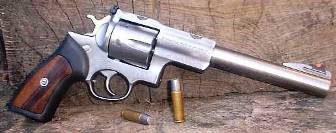
|
|
Ruger Super Redhawk 44 Magnum. |
|
SSK also commissioned a 330 grain GC .44 bullet, although this bullet
has a slightly smaller ogive (.300") and meplat (.270") than does the original
320 gain PB SSK bullet (.322" and .280" respectively). In fact this bullet more
closely resembles the .41 SSK ogive and meplat than it does the 320 grain .44.
In any event, when loaded on top of 20.0 grains of W296, the 330 SSK delivered
very good accuracy and 1313 fps from the SBH revolver. Once again, the SSK
profile is just a wee bit too long to cycle through the Marlin, and it was felt
that little would be gained over the 320 SSK by similar deep seating of the
heavier, longer bullet, so no tests were run with ammo so loaded.
Back in the early 1990s Lyman introduced a blunt, heavyweight bullet for
the .44 Magnum. The Lyman 429649 weighs 338 grains when cast of WW alloy and is
a GC-FP design reminiscent of some of the classic African solids in shape. This
bullet has a large amount of full-diameter bearing surface forward of the crimp
groove, so it's important to size them to fit your revolver's throats, or else
they won't chamber. When this blunt sledgehammer is loaded on top of 18.3 grains
of W296 it generates 1226 fps with good accuracy from the stainless SBH. This
load feeds from the magazine fine in the Marlin 1894, but the extended
full-diameter bearing surface is too long to allow the round to chamber. If one
wanted to shoot this bullet from their Marlin lever-gun, some minor throat work
should clear this issue up (although it's not clear that the 1 in 38" twist of
the barrel would fully stabilize this bulldozer).
The LBT 350 grain WLN-GC, loaded into .44 Magnum cases over 17.5 grains
of W296, was found to deliver good accuracy and 1166 fps from the Ruger SBH.
This combination chambered easily in the SBH and left ample room for creep, with
minimal problems from flamed bullet noses (in contrast to the 320 WLN). The 350
WLN cycles (albeit roughly) and chambers just fine in the Marlin 1894. However,
groups at 50 yards were quite poor, with almost half of the shots key holing
(just for the record, the velocity was 1410 fps). Clearly, at 350 grains we have
passed the limit of what the 1 in 38" twist of the Marlin's barrel is able to
effectively stabilize at .44 Magnum velocities.
SSK added a gas-checked shank onto the stern of their 320 classic to
arrive at the SSK 350 GC (.320" ogive and .285" meplat, i.e. the original SSK
dimensions). This bullet was paired with 17.5 grains of W296, and velocities
averaged 1180 fps, with very satisfying accuracy from the Ruger SBH. As before,
the SSK profile doesn't work well with the Marlin when crimped in the crimp
groove, and I had no desire to deep seat this long, heavy bullet. Based on the
results obtained with the LBT 350, it is doubtful that the 1 in 38" twist would
stabilize this bullet anyway as the two bullets are the same length.
I also have an NEI mould for a .44 caliber 365 grain ogival wadcutter.
Like the Lyman 429649, this bullet also has lots of bearing surface forward of
the crimp groove so it's important to pay attention to sizing them to fit your
revolver, or else they won't chamber. This leaden drum was loaded over 17.0
grains of W296, which delivered 1108 fps and decent accuracy at 25-30 yards with
the stainless SBH. Plinking at targets on a hillside 75-80 yards away revealed
an interesting trend -- roughly half of the shots fired smacked the target
dead-on, while the other half missed by anywhere from 5 to 20 feet. The bullets
were clearly starting to tumble somewhere in the 50 to 70 yard range. With the
long nose and porky ogive of this ogival wadcutter, loading it into the Marlin
wasn't even attempted, as this would most certainly tie up the gun and probably
require considerable frustration to remove.
Warning! What
follows is a mathematical exercise intended for comparison purposes only. This
is not intended to quantify the actual penetration of bullets, but rather to
simply demonstrate the factors involved in bullet penetration and allow some
simple comparisons to be made. If this model doesn't sing the praises of your
favorite bullet, that doesn't mean that your favorite bullet is a bad bullet,
just that there are others out there that might out perform it. Remember, this
is just a model. You have been warned....
The ability of a non-expanding bullet to crush and displace tissue is a
function of its momentum and its meplat. Ignoring the role of the meplat for the
moment, we can calculate momentum by multiplying bullet weight (in grains) times
velocity (fps) and diving by 7000 (grains/pound). The velocity data presented
above can be reduced down to the following table. As we can see, optimum
momentum is obtained with 320-330 grain bullets in the .44 Magnum Super
Blackhawk (somewhat hotter loads are possible in the Super Redhawk, DW and Colt
Anaconda, so all of these numbers would be offset upwards).
|
Sixgun |
Momentum |
Momentum/meplat area |
|
300 @ 1375 |
58.9 |
120 (SAECO), 99.4
(Lyman), 87.3 (RCBS), 82.8 (LFN) |
|
320 @ 1350 |
61.7 |
82.0 (SSK), 64.2
(WLN) |
|
330 @ 1300 |
61.3 |
87.6 (SSK) |
|
340 @ 1250 |
60.7 |
85.4 (Lyman) |
|
350 @ 1200 |
60.0 |
79.5 (SSK), 66.1
(WLN) |
|
365 @ 1100 |
57.4 |
50.6 (NEI) |
| |
|
|
|
Lever-gun |
|
|
|
300 @ 1700 |
72.9 |
147 (SAECO), 123
(Lyman), 108 (RCBS), 107 (LFN) |
|
320 @ 1400 |
64.0 |
85.3 (SSK) |
| |
|
|
|
Reference |
|
|
|
250 @ 1200 |
42.9 |
69.6 (Lyman 429421
Keith .44 Special load) |
|
250 @ 1400 |
50.0 |
81.2 (Lyman 429421
.44 Magnum load) |
It is reasonable to hypothesize that the amount of tissue crushed by a
bullet is directly proportional to the frontal surface area of the meplat, and
since crushing tissue constitutes work and depletes the bullet of momentum, it
follows that the depth of penetration is going to be inversely proportional to
meplat frontal surface area (i.e. larger meplat = less penetration, all other
things being equal). The simplest comparison therefore is to simply divide the
momentum by the meplat frontal surface area (calculated here in square inches).
This model assumes homogenous "tissue" and ignores the drag on the ogive, and
any possible change in meplat diameter -- remember this is just a model for
comparative purposes. The next step would be to compare the penetration of all
of these bullets in standard medium (like John Linebaugh does in his seminars),
and see how well this mathematical model holds water in wet newsprint.
The clear penetration winner from this analysis is the SAECO 300 grain
RNFP, but that is undoubtedly a result of it having by far the smallest meplat
of the group (which would suggest the narrowest wound channel). For means of
comparison, similar calculations were carried out for the Keith .44 Special load
(the Lyman 429421 at 1200 fps) and the same bullet at full throttle in a .44
Mangum load (1400 fps). Comparing these results, we find some interesting
observations. First off, several of these heavyweight loads are predicted to
penetrate less than the standard .44 Magnum load, or even Elmer Keith's
.44 Special load! (read that sentence again and reflect on how clever Elmer
Keith really was!) The LBT 320 WLN, the LBT 350 WLN and the NEI 365 ogival
wadcutter all come up short of the Keith SWC (in either load). To be sure, these
heavyweights would leave a devastating wound channel in their wakes, but this
simple model suggests that they would not penetrate as deeply as the LBT 300
LFN, the RCBS and Lyman 300 SWC's, the SSK 320, 330 and 350 FP's, and the Lyman
429649, all of which would penetrate more deeply than the "standard" .44 Magnum
load.
|
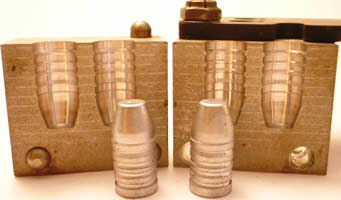
|
|
The SSK 320 Gr. Mould and Bullets. |
These trends show that the simple mantra of "more bullet weight + more
meplat" does not necessarily equate to deeper penetration. After all, the meplat
is the brake that stops the bullet. Admittedly, this model really amounts to
little more than an entertaining exercise in mathematics, but it serves to
illustrate that penetration depth and wound channel diameter are inversely
related (as one goes up, the other goes down) and that choice of a bullet design
represents a compromise between these two performance metrics. Obviously, the
reason for choosing heavier than normal bullets is to obtain
greater than
|
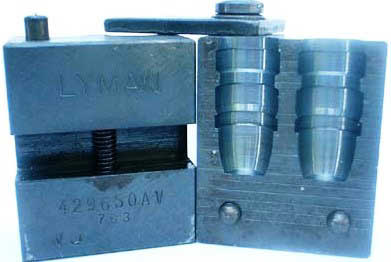
|
|
Lyman 429650 mould. |
normal penetration, so one selection criterion would be to eliminate from
consideration all bullets below the threshold of the "standard" .44 Magnum load.
From the remaining bullets, a sensible second parameter would be the largest
possible meplat for the greatest tissue crushing capability. Combining these two
selection criteria focuses the discussion on those bullets with values in the
80s in the table above (the SSK’s, the Lyman 429649, LBT LFN and RCBS SWC). It
is worth noting that all of these bullets have meplats that are 69-72% of the
bullet diameter (recall that Elmer Keith settled on a meplat diameter of about
70% for his last 3 SWC's).
Looking at the Super Blackhawk numbers, the best performance is turned
in by bullets in the 300-340 grain weight range, with a peak in terms of
velocity and momentum at about 320-330 grains, providing an answer to our
initial question ("Is all this extra weight useful for a .44 Magnum revolver, or
is it just too much of a good thing?"). There are a number of excellent cast
bullets in this weight range for the handgun hunter to choose from. In choosing
one of these bullets, an issue that should be kept in mind is that heavier than
normal bullets do print to a higher point of impact than do standard weight
bullets. If you have a revolver that tolerates heavy bullets well (i.e. has
sufficient sight adjustment to regulate point of aim to coincide with point of
impact), then any of these bullets will provide good service. But if you have a
gun that is limited in terms of what bullet weights will "shoot to the sights",
you might want to shift your focus towards the lighter end of this group. After
all, the whole point of shooting is hitting what you're shooting at, and if you
can't place the bullet precisely where you want it, there's not much point in
dropping the hammer.
For the Super Blackhawks, there are a lot of good choices. The best
accuracy was turned in by the 300 grain GC-SWC's from Lyman and RCBS and the
various different weight SSK bullets. These are all excellent bullets, but my
favorite overall is the 320 grain SSK; this bullet can, and has, done it all.
And while it's not a very efficient bullet for the .44 Magnum, I can't help but
think of wild hogs and Russian boar when I look at the NEI 365 ogival wadcutter;
although this bullet is limited in terms of both velocity and penetration, it's
a definitive short-range, heavy-duty bludgeon (but it's a poor choice for pretty
much anything else).
The LBT 320 WLN is a specialized bullet that is really only suitable
only for the Ruger Super Redhawk and the Dan Wesson .44 Magnum revolvers. It
will not feed in the Marlin when loaded in .44 Magnum cases. While it can be
loaded in the Super Blackhawk and S&W N-frame .44 Magnums, the meplat comes
right up to the mouth of the cylinder and any bullet creep will
tie up the cylinder. This bullet can be loaded to function in these guns by
loading it into .44 Special cases, but it's doubtful that it's worth the effort.
There are much better choices out there for these guns.
|
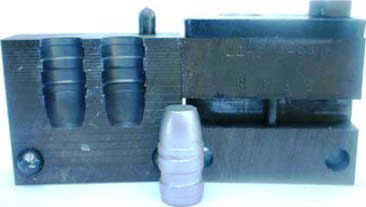
|

|
|
RCBS 44
300 Gr. SWC GC Mould and Bullet. |
For the Marlin 1894 lever-gun, there is a clear advantage to the 300s
(SAECO, LBT LFN, Lyman or RCBS 300 GC-SWC) at 1700 fps. All will deliver good to
excellent accuracy and more than enough thump to handle anything I'm going to
point that sweet little carbine at. The heavier bullets have specialized
profiles that make them difficult (or impossible) to use in this gun and the
350s don't stabilize properly with the 1 in 38" twist.
So, for the .44 Magnum, it appears that the optimum bullet weight (in
terms of penetration) is in the range of 300 to 330 grains. Today we have many
fine choices for cast hunting bullets for the .44 Magnum, but it is clear that a
lot of good thinking went into the design of the Keith 429421 and the SSK 320.
The quality of these two designs is really showcased now, years after their
design, when we compare them to all the rest of these challengers. Truly, both
bullets are landmarks for the handgun hunter. Good teachers are a blessing
indeed.
|